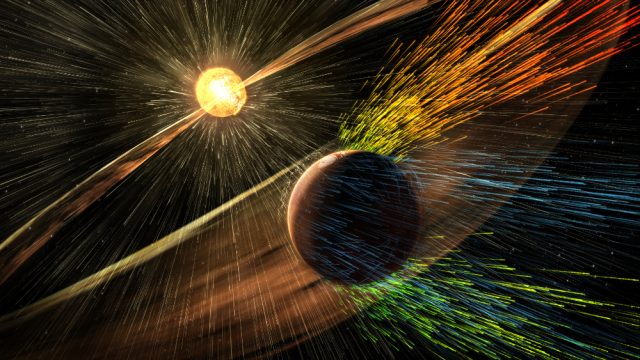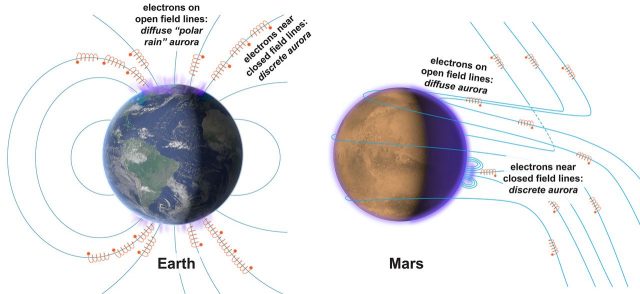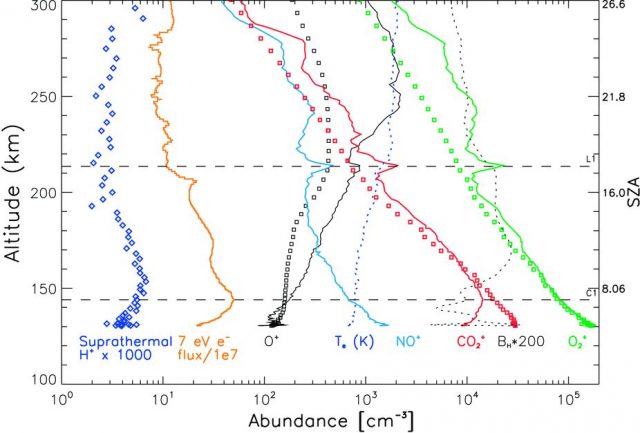MAVEN and how the sun blew Mars atmosphere

We love Mars. Nobody is sure about the exact reason, but we love it. Is it the red color that caught our attention long before the spacecrafts? Or is it the tall mountains and deep valleys they revealed? It is probably a mix of all of the above and much more. It is also the idea of having a twin planet in our Solar System, a planet that could harbor life millions of years ago or maybe today. Even though Venus is much more similar in size to our planet Earth, we still see Mars as something closer to us. Mission after mission, science supports this idea and talks about water, water everywhere. But for water to be stable at Mars’ surface a thick atmosphere is required. However, such a thick atmosphere is not longer there, where did it go? This question is one of the main science drivers of NASA’s MAVEN mission. We want to understand how Mars lost its atmosphere and why it was unable to retain the air, which gets thinner and thinner every day and will surely disappear at some point in the future.
MAVEN stands for Mars Atmosphere and Volatile EvolutioN. The mission is in orbit around the red planet since September 2014 and recently reached its first Earth year working on Mars 1. This implies about two-thirds of its primary science mission, now extended for an additional year. The general picture that emerges from MAVEN data is, broadly speaking, what we already thought about the general processes operating in the upper atmosphere. Still, many details were missing and MAVEN was designed to fill the gap in our understanding. Moreover, surprises have been found all over the way. The mission was designed to have an eccentric orbit with periapsis at 150 km (sometimes down to 125 km) and apoapsis above 6000 km over the planet’s surface. The orbit is highly inclined, so the precession of the periapsis in latitude and time will hopefully provide an excellent mapping of Mars’ high atmosphere and its surrounding space.
As outlined in the initial report [Ref. 1] MAVEN has examined not only the structure of the magnetosphere and the ionosphere, but it has also studied the energetic drivers from the Sun that could control these regions of the atmosphere. These include extreme ultraviolet radiation, solar wind, and solar storms, among others. Most notably, MAVEN witnessed the response of the planet to an interplanetary coronal mass ejection that happened in March 2015 2. The response included the formation of what is called diffuse aurorae 3 and deformation of the magnetosheath and the bow shock, as well as an enhancement of the pick-up ions, which are the ions stole from the neutrals around the planet which are carried into the magnetic field. As shown in Figure 1, the solar wind continuously takes ions from the upper atmosphere in two preferential directions. The tail behind the planet represents the solar wind blowing the atmosphere and it represents about three-fourths of the atmospheric loss. The remaining fourth, still a substantial amount, is perpendicular to this direction due to the electric and magnetic fields of the moving charged particles. The atmospheric loss was increased about an order of magnitude during the March solar storm. Since the conditions in the early Solar System resembled the conditions of this now singular event, the atmospheric loss should have been substantially greater at that time.

The detection of diffuse aurorae is not exclusive of solar storms but seems to be a counter-intuitive consequence of the weak Martian magnetic field, strongly related to the crustal fields. Discrete, Earth-like aurorae had already been observed by Mars Express 4 but MAVEN has shown the existence of diffuse aurora extended for most of the night side of the planet and not only related to solar storms. These can reach almost any latitude, contrarily to the discrete features usually restricted to polar latitudes seen on our planet. Figure 2 shows how the diffuse aurora is produced by electrons trapped in open field lines while electrons near closed field lines (due to crustal fields) produce more Earth-like aurorae. Contrarily to what one could think, it is the weak magnetic field of Mars which causes events distributed all over the planet.
One of the main goals of the MAVEN mission is to determine the structure and composition and variability of the thermosphere and the ionosphere, since this is going to determine the response of the atmosphere to the energetic drivers and, at last instance, this will determine the atmospheric loss. For doing so, the spacecraft dips at the sub-solar point sometimes reaching 125 km over the surface, in what is called Deep Dip campaign 5. This allows measuring the distribution of neutrals, ions and the thermal profile of the upper atmosphere. MAVEN data include many previously unmeasured ions and neutral, at a level of the atmosphere where solar heating from ultraviolet radiation is maximum. MAVEN found an unexpected level of variability from orbit to orbit and even within individual orbits. Solar forcing does not seem to control this unforeseen variability and the ionosphere revealed by MAVEN is as dynamical as the neutral atmosphere to which it is coupled. While better theoretical models are required to fully understand these results, they constrain our current estimates of the volatile escape.

Surprises always arise whenever we have a dedicated mission at other planets. Apart from the aurora discovery described above, MAVEN has also found other unanticipated discoveries. One of my favorite ones, for reasons to be obvious in short, is the observation of dust at extremely high, orbital altitudes, above 150 km 6. This has been interpreted as interplanetary in origin, but it could also be related with ground-based observations of plumes reaching as high as 250km over Mars’ surface7, in which I was involved. This is a very exciting discovery, which, if confirmed, could alter our understanding of sources and sinks of interplanetary dust in the inner part of our Solar System. The mission has still a long way to go, and possibly once all data are ready our interpretation of the phenomena will change, as long as we only have so far a preliminary analysis of initial data. Complementing the work of rovers on the surface of the red planet, MAVEN is like a time machine describing not only the current upper atmosphere of Mars but also the past, thick and possibly warm that once let the water flow through Martian rocks.
References
- B.M. Jakosky et al. (2015). Initial results from the MAVEN mission to Mars. Geophysical Research Letters 42, 8791 – 8802, DOI: 10.1002/2015GL065271 ↩
- B.M. Jakosky et al. (2015). MAVEN observations of the response of Mars to an interplanetary coronal mass ejection. Science 350, 6261, DOI: 10.1126/science.aad0210 ↩
- N.M. Schneider et al. (2015). Discovery of diffuse aurora on Mars. Science 350, 6261, DOI: 10.1126/science.aad0313 ↩
- J.L. Bertaux et al. (2005). Discovery of an aurora on Mars. Nature 435, 790-794. DOI: 10.1038/nature03603. ↩
- S. Bougher et al. (2015). Early MAVEN Deep Dip campaign reveals thermosphere and ionosphere variability. Science 350, 6261, DOI: 10.1126/science.aad0459 ↩
- L. Andersson et al. (2015). Dust observations at orbital altitudes surrounding Mars. Science 350, 6261, DOI: 10.1126/science.aad0398 ↩
- A. Sánchez-Lavega A. et al. (2015). An extremely high-altitude plume seen at Mars’ morning terminator, Nature 518, 525-528, DOI: 10.1038/nature14162 ↩
3 comments
[…] Posted in Noticias, Planetary Science, Science | 0 comments […]
[…] [Leer la entrada completa en Mapping Ignorance] Tweet […]
[…] A todos nos encanta Marte. No sabemos muy bien por qué pero el hecho es que nos gusta. Puede que sea porque estando tan próximo sea tan igual y tan diferente a la Tierra a la vez. Uno de […]